
dear reader
Ah, how good it is to be among people who are reading
Rainer Maria Rilke
This blog has been set up to host a Lockdown Reading Project, looking at how living under lockdown restrictions for prolonged periods of time has affected people’s reading habits, their ability to concentrate and their motivation. You will find blog posts describing different participants’ individual experiences of reading during a pandemic, plus some book recommendations. If you would like to participate in the project, please contact us here.
Lockdown lethargy – is it a thing? For me, certainly, I’m sorry to say. At the beginning of the first lockdown in March 2020 I thought I would use the enforced seclusion at home to plough my way through substantial 19th century novelists: Dickens, Trollope, George Eliot, Elizabeth Gaskell, the Brontes, Wilkie Collins and many, many more. I have read and loved novels by all of those authors, and thought I would fill in the gaps. To my surprise, I couldn’t bring myself even to pick up a single one of them, let alone embark on reading them. It was disconcerting – what had happened to my concentration? I turned to shorter, less demanding works, but couldn’t finish them. An unfinished book haunts me with a sense of failure, but I couldn’t muster the energy to persevere.
After several conversations with people who, it turned out, were experiencing the same dispiriting lack of motivation, I decided it would be interesting to see how widespread this malaise was. Was lockdown exerting some mysterious negative influence, draining us of energy? Or did hardier souls than me find the wherewithal to knuckle down and read all those tomes they had been meaning to read for years?
Hence the Lockdown Reading Project. Here you will find how other people have experienced reading under lockdown, and gain some book recommendations along the way. I hope you enjoy reading people’s musings on their reading, or failure to read, in these strange, unsettling times.
Featured
- New Year’s Eve
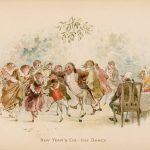 We close the year with a final flourish from the Twigs, with this delightful illustration by Robert Dudley of their New Year’s Eve dance at Ruddock Hall. Ruddock Manor is fuller than ever, I think, There is Goldfinch the banker and little Lord Spink, Tom Titter is here, and Sir Twitterty Tweet And that gay … Read more
We close the year with a final flourish from the Twigs, with this delightful illustration by Robert Dudley of their New Year’s Eve dance at Ruddock Hall. Ruddock Manor is fuller than ever, I think, There is Goldfinch the banker and little Lord Spink, Tom Titter is here, and Sir Twitterty Tweet And that gay … Read more - Twenty Fourth Day of Advent – Christmas Eve
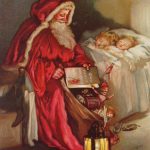 Now wake little people dressed in white, Old Father Christmas came last night; He crammed your stocking – and, children, look! He brought you a coloured picture book. from Old Father Christmas by Lizzie Mack and Robert Ellice Mack, published in London by Ernest Nister, 1889. I have been looking forward to posting this picture … Read more
Now wake little people dressed in white, Old Father Christmas came last night; He crammed your stocking – and, children, look! He brought you a coloured picture book. from Old Father Christmas by Lizzie Mack and Robert Ellice Mack, published in London by Ernest Nister, 1889. I have been looking forward to posting this picture … Read more - Twenty Third Day of Advent
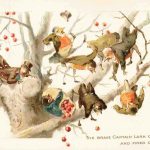 This illustration is from The Twigs, or, Christmas at Ruddock Hall illustrated by Robert Dudley, published in London by Castell Brothers, 1890. Yesterday we mused on why robins are associated with Christmas, which led to the discovery that Victorian postmen were nicknamed Robins. But why is the nation’s favourite bird called a robin in the … Read more
This illustration is from The Twigs, or, Christmas at Ruddock Hall illustrated by Robert Dudley, published in London by Castell Brothers, 1890. Yesterday we mused on why robins are associated with Christmas, which led to the discovery that Victorian postmen were nicknamed Robins. But why is the nation’s favourite bird called a robin in the … Read more - Twenty Second Day of Advent
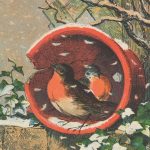 Some flowerpot robins from The Bright Surprise for Little Eyes, published in London by the Sunday School Union, 1884. We are so used to associating robins with Christmas that I doubt we ever give much thought as to why this is. As with all such questions there are many answers. However, one thing we … Read more
Some flowerpot robins from The Bright Surprise for Little Eyes, published in London by the Sunday School Union, 1884. We are so used to associating robins with Christmas that I doubt we ever give much thought as to why this is. As with all such questions there are many answers. However, one thing we … Read more - Twenty First Day of Advent
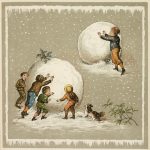 from Oh Dear Oh Look at the Snow by Jack Frost, published by Dean & Son, 1884. I know we’ve posted a couple of snow scenes from this book by the pseudonymous Jack Frost, depicting children making huge snowballs, but I love this one and can’t bear to leave it out. Why do I love … Read more
from Oh Dear Oh Look at the Snow by Jack Frost, published by Dean & Son, 1884. I know we’ve posted a couple of snow scenes from this book by the pseudonymous Jack Frost, depicting children making huge snowballs, but I love this one and can’t bear to leave it out. Why do I love … Read more
The Dear Reader Blog Crime Scene Podcast
Lockdown Reading
- Grace
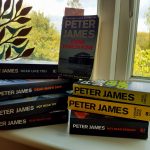 At the beginning of lockdown in the spring of 2020 I thought I would make use of the extra time at home to catch up on my ever growing, and increasingly daunting ‘to be read’ pile
At the beginning of lockdown in the spring of 2020 I thought I would make use of the extra time at home to catch up on my ever growing, and increasingly daunting ‘to be read’ pile - I know I have books that I will never open, and on a few occasions I’ve bought them just because they are beautiful to look at!
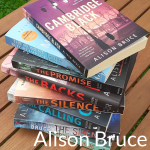 I have at times used audiobooks as company in the middle of the night, but apart from that, I have just picked the books that look like an interesting mystery.
I have at times used audiobooks as company in the middle of the night, but apart from that, I have just picked the books that look like an interesting mystery. - For many years I’ve read fairly randomly; nearing the end of a novel I’d decide what was the logical successor and then illogically read something entirely different.
 I favour reading fiction, with occasional biographies, usually about writers or composers.
I favour reading fiction, with occasional biographies, usually about writers or composers. - It is very easy to put down an electronic book and forget you have it. A physical book sits by your chair, or by your bed and is a reminder to carry on reading.
 Have you read more or less during lockdown, or much the same as usual? Well, it rather depends on what you define as “usual.” Before I retired, about a year prior to Lockdown, most of my reading was done on the train during my commute.
Have you read more or less during lockdown, or much the same as usual? Well, it rather depends on what you define as “usual.” Before I retired, about a year prior to Lockdown, most of my reading was done on the train during my commute. - I have steered away from pandemic themes …
 I read quite a lot in normal times and so I think my reading consumption has not much changed in terms of quantity
I read quite a lot in normal times and so I think my reading consumption has not much changed in terms of quantity
Hidden Cambridge
- Stinkpipes
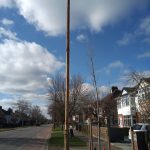 You may feel that Cambridge is a rather clean and fresh-smelling kind of place, with all the greens and commons. But one piece of street furniture, found all over the place, suggests it was once a much smellier city.
You may feel that Cambridge is a rather clean and fresh-smelling kind of place, with all the greens and commons. But one piece of street furniture, found all over the place, suggests it was once a much smellier city. - The Leper Chapel and the largest fair in medieval Europe
 The Barnwell Junction end of Newmarket Road is now more commonly known for Cambridge United, but it was once the site of a leper hospital, known as Stourbridge Hospital.
The Barnwell Junction end of Newmarket Road is now more commonly known for Cambridge United, but it was once the site of a leper hospital, known as Stourbridge Hospital. - Hunting the ghosts of local businesses
 Buildings often tell stories and hint at their history
Buildings often tell stories and hint at their history - Tony’s Trough
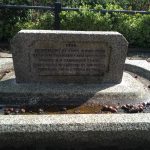 Between a set of bike racks and next to Lloyd’s Bank, on a north Cambridge traffic island, there is a rather strange monument: a memorial dog trough. This was erected in 1934, in memory of a dog named Tony. It was put there at the request of Prince Chula of Siam, who studied at Trinity … Read more
Between a set of bike racks and next to Lloyd’s Bank, on a north Cambridge traffic island, there is a rather strange monument: a memorial dog trough. This was erected in 1934, in memory of a dog named Tony. It was put there at the request of Prince Chula of Siam, who studied at Trinity … Read more - Chesterton Mill
 Teenage me had a paper round and I used to deliver papers to a converted mill in the mid-1990s. It was the office building of an educational publisher called Pearson Publishing. Their order was all the daily papers plus a large amount of trade press. I used to have to do that drop-off first, then … Read more
Teenage me had a paper round and I used to deliver papers to a converted mill in the mid-1990s. It was the office building of an educational publisher called Pearson Publishing. Their order was all the daily papers plus a large amount of trade press. I used to have to do that drop-off first, then … Read more
Tower Treasures
- New Year’s Eve
 We close the year with a final flourish from the Twigs, with this delightful illustration by Robert Dudley of their New Year’s Eve dance at Ruddock Hall. Ruddock Manor is fuller than ever, I think, There is Goldfinch the banker and little Lord Spink, Tom Titter is here, and Sir Twitterty Tweet And that gay … Read more
We close the year with a final flourish from the Twigs, with this delightful illustration by Robert Dudley of their New Year’s Eve dance at Ruddock Hall. Ruddock Manor is fuller than ever, I think, There is Goldfinch the banker and little Lord Spink, Tom Titter is here, and Sir Twitterty Tweet And that gay … Read more - Twenty Fourth Day of Advent – Christmas Eve
 Now wake little people dressed in white, Old Father Christmas came last night; He crammed your stocking – and, children, look! He brought you a coloured picture book. from Old Father Christmas by Lizzie Mack and Robert Ellice Mack, published in London by Ernest Nister, 1889. I have been looking forward to posting this picture … Read more
Now wake little people dressed in white, Old Father Christmas came last night; He crammed your stocking – and, children, look! He brought you a coloured picture book. from Old Father Christmas by Lizzie Mack and Robert Ellice Mack, published in London by Ernest Nister, 1889. I have been looking forward to posting this picture … Read more - Twenty Third Day of Advent
 This illustration is from The Twigs, or, Christmas at Ruddock Hall illustrated by Robert Dudley, published in London by Castell Brothers, 1890. Yesterday we mused on why robins are associated with Christmas, which led to the discovery that Victorian postmen were nicknamed Robins. But why is the nation’s favourite bird called a robin in the … Read more
This illustration is from The Twigs, or, Christmas at Ruddock Hall illustrated by Robert Dudley, published in London by Castell Brothers, 1890. Yesterday we mused on why robins are associated with Christmas, which led to the discovery that Victorian postmen were nicknamed Robins. But why is the nation’s favourite bird called a robin in the … Read more - Twenty Second Day of Advent
 Some flowerpot robins from The Bright Surprise for Little Eyes, published in London by the Sunday School Union, 1884. We are so used to associating robins with Christmas that I doubt we ever give much thought as to why this is. As with all such questions there are many answers. However, one thing we … Read more
Some flowerpot robins from The Bright Surprise for Little Eyes, published in London by the Sunday School Union, 1884. We are so used to associating robins with Christmas that I doubt we ever give much thought as to why this is. As with all such questions there are many answers. However, one thing we … Read more - Twenty First Day of Advent
 from Oh Dear Oh Look at the Snow by Jack Frost, published by Dean & Son, 1884. I know we’ve posted a couple of snow scenes from this book by the pseudonymous Jack Frost, depicting children making huge snowballs, but I love this one and can’t bear to leave it out. Why do I love … Read more
from Oh Dear Oh Look at the Snow by Jack Frost, published by Dean & Son, 1884. I know we’ve posted a couple of snow scenes from this book by the pseudonymous Jack Frost, depicting children making huge snowballs, but I love this one and can’t bear to leave it out. Why do I love … Read more
Gallimaufry
- Angel roofs
 There are more angel roofs in East Anglia than anywhere else in the country
There are more angel roofs in East Anglia than anywhere else in the country
Follow on Instagram
If you like what we have on the blog you can see more up to date contributions on our Instagram.
Contributors
About Us
Rosalind Esche

Librarian, avid reader of detective novels and Victorian fiction, I love the North Norfolk coast, Suffolk countryside and angel roofs in East Anglian churches. And trees.
Glenn Jobson

Engineer, musician and filmmaker, with an interest in travelling in old vehicles and on bicycles.
I worked on the Tower Project at Cambridge University Library, probably the happiest time of my entire working life. I was part of a small team tasked with cataloguing online all books received between 1800 and 1925. We catalogued 220,000 before the funding ran out. The books were stored in the Library’s iconic 17 storey tower – hence the name Tower Project. I miss those quirky, intriguing and sometimes bizarre books, so now I write about them on this blog (see Tower Treasures).
I enjoy East Anglia’s wealth of medieval churches with their stunning rood screens and angel roofs. East Anglia has more angel roofs than anywhere else in the country by far – appropriate somehow to our vast, wide open skies.
I’m a bit obsessed with trees (I have planted 17 so far in my garden) and detective fiction.
My cure for low spirits is watching Life on Mars. And being at Lord’s cricket ground with my sons. And standing on Holkham Beach under a vast Norfolk sky.
In April 2020 I started what would become a year long project. I set out to cycle each and every lane and drove road in the fens to the south east of the River Cam in Cambridgeshire, somewhere I knew but had forgotten. Initially I chose random routes but soon formalised either the start or the end of the route so I could photograph the same field from the same spot each time I passed, a selfie as well. The route is at least 30km and I have cycled it most days for one year. One year on I have covered over 10,000km on each and every drove road and lane, past every perch and rood of the fenland landscape and rediscovered this fascinating place. The photographs now form the basis of a short film that will be accompanied by a new soundtrack that I am working on, a soundtrack composed entirely on vintage analogue synthesisers and recorded direct to cassette tape. One year, 10,000kms, two bikes and one life saved.
